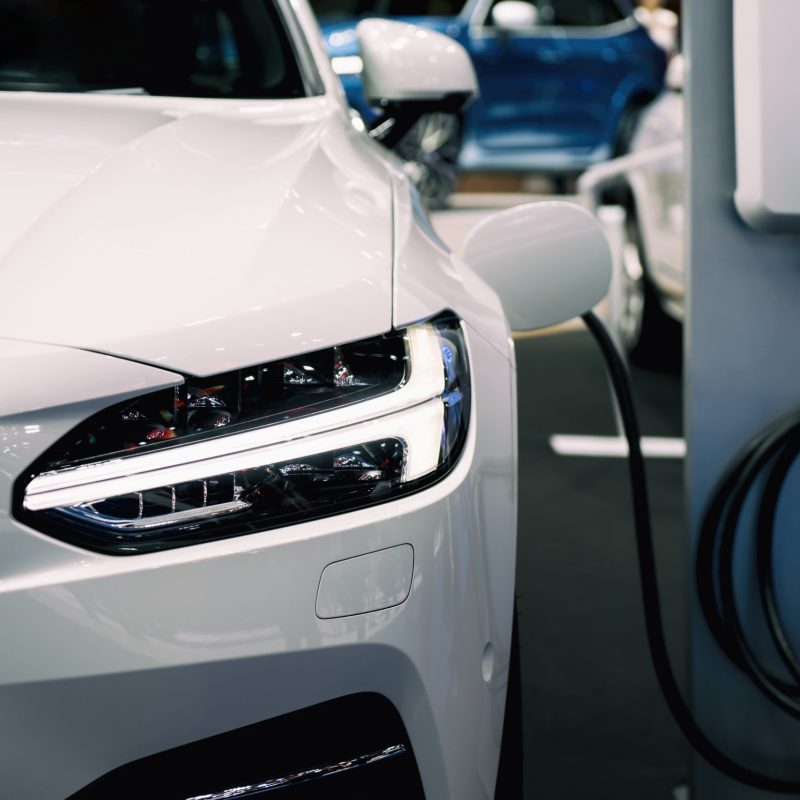“One website published that a lot of people Googled electric vehicles,” said Culverhouse’s Dr. Mesut Yavuz. “And the number one question people asked Google about electric vehicles turned out to be, ‘Can I take an electric vehicle to a car wash?’”
 Though EVs are safe for car washes, the confusion is understandable. As an emerging technology, electric vehicles invite a host of questions from consumers. Are they a good investment? Are they safe? How do people decide whether to buy them or not? How difficult will it be to charge them? To take them on trips? Do they make sense for corporate fleets? Culverhouse faculty Drs. Jonathan Hall, Tigran Melkonyan, Shawn Mobbs, Michael Price, and Mesut Yavuz recently gathered around Thai food to discuss the current EV landscape, and where things might be going in the future.
Though EVs are safe for car washes, the confusion is understandable. As an emerging technology, electric vehicles invite a host of questions from consumers. Are they a good investment? Are they safe? How do people decide whether to buy them or not? How difficult will it be to charge them? To take them on trips? Do they make sense for corporate fleets? Culverhouse faculty Drs. Jonathan Hall, Tigran Melkonyan, Shawn Mobbs, Michael Price, and Mesut Yavuz recently gathered around Thai food to discuss the current EV landscape, and where things might be going in the future.
Ready or Not
“Only 10 years ago, there were just about 14 different models offered by 11 different manufacturers, and now it is 120 plus different models offered by 20 plus different manufacturers,” said Yavuz, who in his research draws on data about EV ownership and socio-economic conditions and uses advanced analytics to forecast future purchasing activity and optimize the EV ecosystem. Clearly, EVs are finding a market, but why?
Dr. Tigran Melkonyan studies what motivates buyer decisions in products like electric vehicles, but that kind of research can be a tall order. Social media, for instance, can share information — accurate or not — that shapes behavior. “My 13-year-old daughter comes by, (says) ‘oh, do you know that when you charge a Tesla, the door may get locked and you may not be able to unlock it during charging?’” Melkonyan said. “Social media is full of inaccurate and accurate information as well as positive and adverse publicity about EVs.” With any new technology, consumers are looking for clues about its reliability and value, while established technologies benefit from familiarity. “Most consumers have limited experience with electric vehicles, unlike traditional combustion engine vehicles. This lack of familiarity leads to significant uncertainty, making social media and other information sources particularly influential in shaping their purchasing decisions,” he said.
But You Can’t Make Me Drive It
One of the attractive features of EVs, of course, are their low carbon footprint. To reduce the national carbon footprint, the federal government introduced Corporate Average Fuel Economy (CAFE) standards in 1975. CAFE standards require a baseline fuel efficiency from automakers, and the standard continues to go up. Still the desired emissions changes do not always appear.
That’s the stick, but on the carrot side, individual states have offered subsidies and tax breaks for EV buyers. The problem is that the data suggests that EV owners skew toward high-income brackets, and often own more than one vehicle. It is likely that the EVs are additions to existing fleets, but not replacing other, less fuel-efficient vehicles. Ideally, of course, the owners who would be driving the EVs more, but who is to say? They may be reaping the financial benefits of the subsidy without moving the needle on carbon emissions much. “It’s not about the adoption (of an EV), it’s about what you are actually driving,” Michael Price said. Price’s research, like Melkonyan’s, focuses on the decision-making process under uncertainty and the use of field experiments to understand how a new policy or program will operate at scale. Recently, he and his collaborators have been studying charging infrastructure for EVs. “I can get you to purchase a more fuel-efficient car…but I have the fuel-efficient car and I have the less fuel efficient truck, minivan, whatever. What do I take on the long trip?”
How Do We Fuel This Thing?
Electric power may be better for the environment than fossil fuels, but that doesn’t change the fact that our national transportation infrastructure has been set up for internal combustion engines for over 100 years. That means that while charging stations are on the rise, long trips in EVs still require some planning. Additionally, charging an EV can take 30 minutes or more, versus a quick five minutes at the old-fashioned gas pump. What are people supposed to do while they wait? The solution may be to leverage the captive market ideas of chains like Buc-ees, offering customers shopping and entertainment options while they wait.
Even recharging at work can present challenges. For instance, say a firm has five charging stations, but 20 employees have EVs. What is to prevent five of the employees from leaving their cars parked at a station all day? The answer could be robots, connecting chargers to vehicles during the day and then moving to the next one. Sound crazy? Perhaps, but likely still cheaper than charging stations for every EV-owning employee, especially as EV adoption goes up.
Corporate Fleets
“The city of Toronto has been replacing their bus fleet with electric buses,” Hall said. “They say you need, like, one and a half electric buses per diesel bus.” Why? Charging downtime. So while firms can certainly reap the financial rewards of incentives and tax breaks, as well as the PR benefits of embracing clean energy, few fleet managers are likely to entirely replace their internal combustion or hybrid vehicles with EVs.
Ready for an electric ambulance? Check your gut, and while you do, consider that Yavuz’s research suggests that 50% of ambulances could be replaced with EVs immediately. So what happens when there is an emergency, and all of the available ambulances are charging? They just stop charging, and make the run on whatever power they have at the moment. And if they run out, there will still be gas-powered vehicles to do the job.
EV or Hybrid?
EVs, of course, aren’t the only high fuel efficiency, low-emissions vehicles on the market. They share that space with their cousins, the hybrids, which split the difference between internal combustion and battery power, recharging the batteries when the vehicle brakes. And it’s likely that for now, at least, hybrid vehicles make more financial sense than most EVs—even more than what are called “plug-in hybrids,” which vehicles that essentially have two drivetrains: a gasoline and an electric.
“I suspect we could reduce emissions more by subsidizing hybrid vehicles rather than electric vehicles,” Jonathan Hall said. “…We give up to $7,500 subsidies to EVs, when hybrids typically cost just a few thousand dollars more than the gas version, but can increase gas mileage 30%.” Hall’s research focuses on traffic, including evaluating the impacts of new transportation technologies like EVs on cities. He uses theoretical and empirical methods, including structural and reduced-form approaches, to address his themes.
Though they do still use gasoline, hybrids might represent a logical next step as the U.S. transportation infrastructure shifts to accommodate clean energy vehicles. After all, as Yavuz points out, the data suggests that hybrid option often paves the way for EV adoption. Melkonyan might say that driving a hybrid is building familiarity, making it easier to shift out of an internal combustion mindset.
“If the market takes us to EVs, great. I have no objection to it. But we can probably do more good for the environment by subsidizing hybrids rather than EVs,” Hall said.
No hurry. But recharging robots and new iterations of Buc-ees? Sounds pretty good.
Culverhouse Conversations is an initiative to bring small groups of Culverhouse faculty from different departments and disciplines together, over a meal, for a structured but casual conversation about a given research topic.

